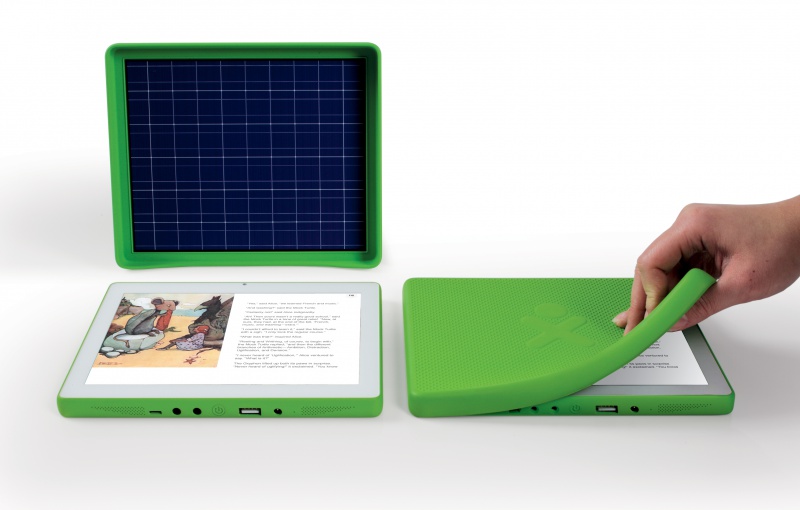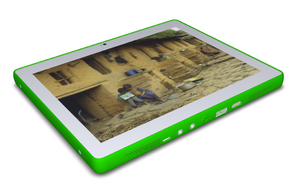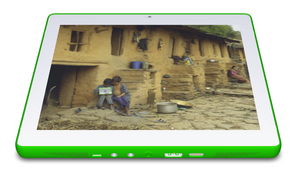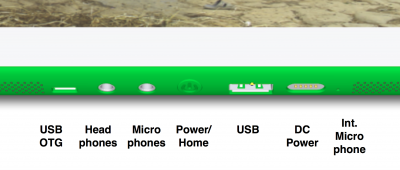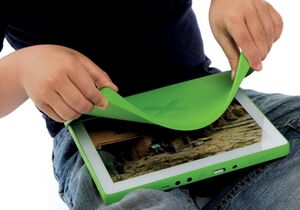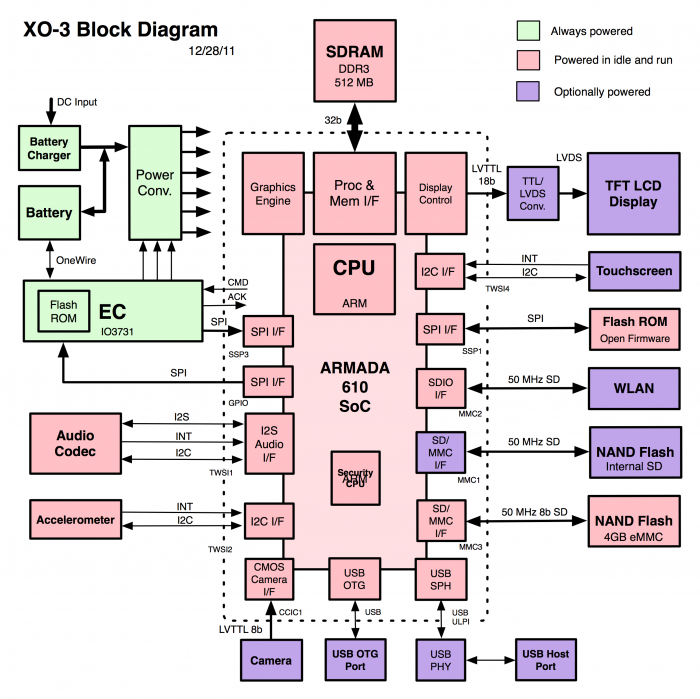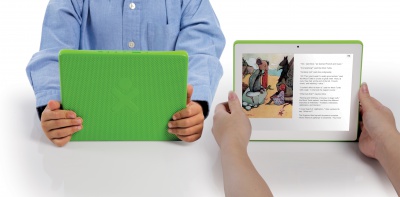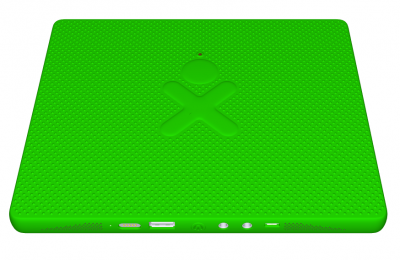XO-3
The XO-3 is a tablet by OLPC that was cancelled in late 2012.<ref>November 29, 2012 OLPC cancels XO-3 tablet, downplays need for new hardware: Design aspects of the XO-3 could be used by other companies, Negroponte says by Agam Shah, IDG News Service</ref> The next planned OLPC hardware release is the XO-4 laptop, a successor to the XO-1.75 and due in 2013.
In 2010 and 2011, OLPC developed a low cost, low power, robust tablet for use by kids. Working prototypes were built in Jan. 2012 for demonstration, software development and hardware testing. The tablet was introduced at the Consumer Electronics Show (CES) in Las Vegas, and received considerable press coverage. The prototype has an 8" display with a 4:3 aspect ratio. The tablet electronics are based around the Armada 610 ARM system-on-a-chip from Marvell, which is also used in the XO-1.75 laptop.
Specifications
- These specifications describe the prototype shown at CES and design goals not included in the prototype. Production units will likely be different
Physical dimensions
- Dimensions: 194mm × 160mm × 13.3mm
- Weight: 0.6 kg (~1.2 lbs);
Core electronics
XO-3 is designed around the Armada 610 system on a chip.
- CPU: Marvell Sheeva ARM (PJ4);
- CPU clock speed: 800 MHz (superscalar and out-of-order instruction execution);
- ARM instruction set compatible (including Thumb-2 and Wireless MMX2);
- ARMv7 architecture compatible;
- 32 KB L1 I-cache, 32 KB L1 D-cache, 256KB L2 cache;
- The 610 includes hardware video encode/decode, Vivante GC1000 3D graphics engine, display controller, USB, SDIO, and other system interface and management functions
- DRAM memory: 512 MB or 1GB DDR3 dynamic RAM;
- Mass storage: 4 GiB to 16 GiB NAND flash in an eMMC device soldered to the motherboard.
- an internal microSD card slot for repair/replacement -- requires soldering the microSD bracket;
- No rotating media.
Unlike many tablets, we are still including an Embedded Controller to handle battery charging and power sequencing (subject to change):
Display
- Main article: Display
- Liquid-crystal display: 8” 4:3 transmissive TFT display;
- Viewing area: 162 mm × 121.5 mm;
- 1024 x 768 resolution (RGB stripe pixel arrangement)
Integrated peripherals
- Touchscreen: Projected Capacitance Touchscreen capable of tracking five simultaneous touches
- Audio: Internal stereo speakers and amplifier; internal monophonic microphone; jacks for stereo external headphones and microphones.
- Realtek ALC5631 audio codec (I2S)
- Camera front facing: integrated color video camera; 640 x 480 resolution at 30 FPS;
- Independent (and undefeatable by software) display of microphone and camera recording status;
- The camera and device driver support disabling AGC and automatic color balancing, to enable its use as a photometric sensor for educational applications;
- Omnivision OV7670
- Optional Rear Facing Camera
- Wireless Networking: Integrated 802.11b/g (2.4GHz) interface; dual antennas;
- Marvell 88w8686 WLAN module, with SDIO interface, on removable module;
- Remains powered while the tablet suspends, waking the tablet if a packet addressed to it arrives.
- Ad-hoc networking and 802.11s mesh support available
- Accelerometer: ST LIS3 three axis accelerometer
- Light Sensor: a reverse biased LED.
External connectors
- DC power: Magnetically attached power supply connector; 5 to 24 V input usable, –32 to +40V input tolerated; power draw limited to 15W (still TBD).
- Maximum Power Point Tracking alters voltage/current for maximum battery-charging power from solar panels
- DC power alt: we are still looking at ways of connecting to the cover;
- Headphone output: standard 3.5mm 3-pin switched stereo audio jack;
- Microphone input: standard 3.5mm 3-pin switched stereo microphone jack; selectable 2V DC bias; selectable sensor-input mode (DC or AC coupled);
- USB: One Type-A USB 2.0 connector; Up to 0.5A power supplied.
- USB OTG: One Type-microAB USB 2.0 connector; Up to 0.5A power supplied, up to 1.8A power consumed.
Battery
- Pack type: 2 cell LiFePO4, approx. 6V series configuration;
- Capacity: hopefully around 20 Watt-hours;
- Integrated into the case; replaceable, but not removable on a regular basis;
- Minimum 2,000 charge/discharge cycles (to 50% capacity of new).
- An optional external battery pack located beneath a 4-watt/m2 Solar Panel that can also charge the internal battery.
See Laptop Batteries or more information.
BIOS/loader
On XO-3, there are two different firmwares installed:
- A small bootloader written in Forth and interpreted by CForth runs on the security processor
- Open Firmware runs on the main (PJ4) processor
The bootloader run by the CForth interpreter on the security processor is responsible for initializing the SoC pins and the main memory. It then loads Open Firmware into main memory and starts it executing on the main processor. This CForth bootloader then continues to execute on the security processor, processing input from the keyboard and touchpad.
Open Firmware (OFW) initializes the system peripherals, then loads the OS kernel into memory and starts executing it. OFW also includes hardware diagnostics.
- A dedicated 1 MiB SPI-interface flash ROM contains both CForth (first 128KB) and OFW
- Hardware support is provided to prevent reprogramming of the OFW flash ROM by malicious software
Environmental specifications
- Temperature: 0 to 50 degrees Celsius (operating); -20 to 60 degrees Celsius (non-operating)
- Humidity: UL certification planned to IP53 (perhaps higher). When closed, the unit should seal well enough that children walking to and from school need not fear rainstorms and dust
- Maximum altitude: –15m to 5000m (14.7 to 7 PSIA) (operating), –15m to 12192m (14.7 to 4.4 PSIA) (non-operating)
- Shock 125g, 2ms, half-sine (operating) 200g, 2ms, half-sine (non-operating)
- Random vibration: 0.75g zero-to-peak, 10Hz to 500Hz, 0.25 oct/min sweep rate (operating); 1.5g zero-to-peak, 10Hz to 500Hz, 0.5 oct/min sweep rate (nonoperating)
Regulatory requirements
- The usual US and EU EMI/EMC (electromagnetic-interference and electromagnetic-compatibility) requirements;
- The tablet will meet IEC 60950-1, EN 60950-1, and CSA/UL 60950-1 (safety) specifications. It also complies with UL 1310 and UL 498. In order to guarantee the safety of children using the tablet, it passes ASTM F 963 (Standard Consumer Safety Specification on Toy Safety, 2003 edition);
- The external power adapter complies with IEC, EN, and CSA/UL 60950-1;
- The removable battery pack complies with IEC, EN, and CSA/UL 60950-1 and UL 2054;
- RoHS (Restriction of Hazardous Substances Directive – EU) compliant.
Block Diagram
Software
There are four distinct pieces of software on the XO-3 tablet:
- User Interface (usually Sugar on the laptop, but possibly something different on the tablet),
- Operating System (Fedora, or Android),
- Open Firmware (OFW),
- Embedded controller (EC) firmware.
Software Restrictions
- the Write activity hangs the tablet when it scrolls, <trac>11321</trac>, <trac>11399</trac>, <trac>11450</trac>,
- suspend and resume are being worked on <trac>10835</trac> <trac>11194</trac> <trac>11142</trac>, are in build os13, but there are some problems, such as two attempts required to suspend <trac>11194</trac>, corruption of cursor <trac>11491</trac>, inability to use USB after resuming <trac>11369</trac>, loss of touchpad function <trac>11496</trac> <trac>11379</trac>, and slightly higher power consumption because DRAM driver terminators remain on,
- audio support in the kernel is being worked on, is in build os13, but there are some problems, such as Record will not record audio,
- graphics performance is not yet tuned, <trac>10830</trac>, and rotate is not yet done, <trac>11115</trac>,
(list last reviewed for os13)
Notes
<references />
More Information
- Official news of cancellation, Nov. 29, 2012
- XO-3 A1 pre-production prototype
- Battery discussion
- Tablet mass
- Firmware
- Open Firmware ARM Startup
Past News Articles
- Golem DE, Jan. 8, 2012
- Engadget, Jan. 8, 2012
- The Verge, Jan. 8, 2012
- Gizmodo, Jan. 8, 2012
- International Business Times, Jan. 8, 2012
- Wall Street Blog, Jan. 8, 2012
- Marvell Press Release, Jan. 8, 2012
- Heise DE, Jan. 7, 2012"
- OLPC plans solar charging, satellite internet for XO-3, July 11 2011
- XO-3, Marvell, and OLPC, May 27, 2010
Long Past News Articles
- Forbes: The $75 Future Computer. Designer Yves Behar shares images and details from One Laptop Per Child's flashy PC plans, Dec. 22, 2009
- Forbes: The Prophet of Cheap. Teach the world to make a $75 computer and you'll feed it for a lifetime. Maybe., Dec. 31, 2009
- IDG News (on PCWorld): OLPC's Negroponte Says XO-3 Prototype Tablet Coming in 2010], May 27, 2010
- Forbes: One Laptop Per Child Revamps Tablet Plans. A sub-$100 computer may launch two years early, but will be missing key features., May 27, 2010
